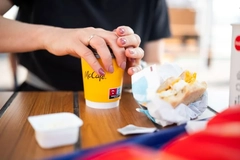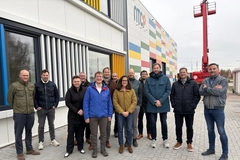Balancing act: Fresh fruit and vegetable packaging juggles fiber and plastic solutions

15 Mar 2023 --- Consumers are driving toward more environmentally and health-conscious lifestyles and food choices, leading to fresh fruit and vegetable packaging innovation, according to Innova Market Insights. We speak to ATS-Tanner and StePac about the latest trends in the fresh food category, including the balance of plastic use, fiber-based solutions and the need for uniform legislation.
Both companies state that fresh fruit and vegetable packaging trends focus primarily on reducing plastic and implementing overall environmentally sustainable and circular practices. This includes reducing or completely removing plastic packaging, transitioning to paper packaging or using recyclable and compostable plastics.
“They are the same trends that we see in other areas of minimizing or eliminating packaging material, replacing plastic with paper, using only recyclable packaging material, making packaging processes more efficient and automating them, simplifying labeling and reducing energy consumption,” Thomas Weber, content manager at ATS-Tanner Banding Systems AG, tells PackagingInsights.
Material complications
Innova Market Insights states that fruit and vegetables are key in consumers’ daily nutrition intake for a healthy lifestyle. The increased demand for fresh and healthy produce has led to a surge in innovative packaging solutions.
The market researcher notes that from biodegradable materials to modified atmosphere packaging (MAP), the trend toward environmental sustainability and shelf life preservation has been driving packaging tech development in the fresh fruit and vegetable space.
“Compostable plastics are an issue as well right now. How many compostable plastics make it to a home or industrial composter? Very little, because there are very few industrial composters and very few people have home composters,” says Dr. Gary Ward, CTO of StePac.
 ATS-Tanner fruit and vegetable banding solutions are made from paper, pursuing increased environmental sustainability. Ward explains that often compostable materials – while trending for fruit and vegetable packaging – are likely to degrade to greenhouse gasses when reaching landfill.
ATS-Tanner fruit and vegetable banding solutions are made from paper, pursuing increased environmental sustainability. Ward explains that often compostable materials – while trending for fruit and vegetable packaging – are likely to degrade to greenhouse gasses when reaching landfill.
“On the other hand, we know that MAP packaging can play a very important role in preserving the quality of fresh produce and reducing waste in the supply chain. It just needs to be professionally designed, responsibly used and recycled,” Ward continues.
Fiber-based innovations
ATS-Tanner created TruePaper, an environmentally friendly, ultrasonic, heat-sealable paper band.
“The elimination of unnecessary packaging is essential. If fruit and vegetables have to be packaged, they should only be done so with recyclable packaging material that can be easily separated by consumers and transferred to the correct, existing recycling streams,” explains Weber.
“Adhesive labels, for example, always end up in the compost because they can’t be easily removed from the peels. And plastic tray packaging is very often simply unnecessary.”
TruePaper consists of optionally virgin or more than 50% recycled fibers. It can be recycled in the standard paper cycle and is suitable for direct food contact. It contains a water-based bonding agent that can be sealed with ultrasonic and heat seal technology.
“We are constantly testing new paper qualities and experimenting with the coating, for example, to increase resistance to wetness. At the same time, however, we want to ensure that even if TruePaper becomes more water-resistant, it can easily be released back into paper fibers in conventional pulpers.”
Food waste fighters
A key component of fresh fruit and vegetable packaging is ensuring that it can be kept fresh efficiently to prevent food waste. Often, plastic is implemented in its packaging to maintain a product’s freshness as its properties lend well to preservation.  Thomas Weber, content manager at ATS-Tanner Banding Systems AG.
Thomas Weber, content manager at ATS-Tanner Banding Systems AG.
“Although it is renewable, paper-based packaging carries a huge ecological impact, mainly due to the high carbon footprint of its production and the fact that it encourages deforestation. In addition, it plays little if any role in protecting the freshness and quality of fresh produce so this will not help combat food waste,” asserts Ward.
According to the Environmental Defense Fund, food waste is an influential contributor to the global waste crisis and produces methane gas that is roughly 80 times more potent than CO2.
“Completely removing the use of the plastic packaging is highly likely to increase food waste, which is already very high and represents about 8% of all global greenhouse gas emissions.”
Using plastic to your advantage
StePac sees “plastic packaging as part of the solution if correctly designed and used responsibly, especially for modified atmosphere packaging. Ward states that if plastic is implemented, the packaging must be collected and mechanically recycled to support a circular economy.
“Plastic packaging is being demonized, yet many of the proposed alternative solutions are likely to be more detrimental to the environment. We need to let the experts guide us and not be misled by greenwashing.”
“Unfortunately, the market is very fragmented right now and there is a lot of greenwashing when a more uniform and logical approach is required,” declares Ward.
Ward continues that the most significant challenges when developing recyclable products are ensuring that they can be manufactured smoothly and efficiently, have the same high level of performance as the existing products in preserving the quality of the product and are cost-effective.
“Supporting a circular economy by recycling plastics, both mechanically and chemically, seems to be the most sensible approach,” adds Weber.
StePac’s plastic-wrapped fresh fruit and vegetable packaging solutions. Innovations for a circular economy
StePac’s R&D focuses on developing modified atmosphere packaging solutions that preserve quality and reduce waste in the supply chain, are lean, support a circular economy and support the transition to automation.
“StePac PPC worked with BASF in 2022 to qualify the use of 30% chemically recycled resins in its polyamide-based films. This is a major step in supporting a circular economy.”
The company also developed and commercialized fully recyclable mono-materials for lidding film applications. Using lidding film instead of conventional clamshells saves 25-30% in plastic. When embedded with modified atmosphere properties, it also reduces food waste.
Innova Market Insights named plastic circularization as one of its top packaging trends for 2023. It cites that although plastic reduction initiatives are gathering pace and renewable alternatives are rising, plastic’s inherent qualities as a lightweight, versatile and hygienic material means that production and consumption continue to increase.
“Now, the main focus for governments and the industry should be on delivering recycle-by-design packaging and recycling systems that can help reestablish plastic within a circular economy,” says the market researcher.
Call for consistent regulation
Weber discusses frustrations around the need for uniform European regulations regarding packaging so ATS-Tanner can create more functional and environmentally sustainable solutions that abide by what is enacted.
“The new European regulation on packaging and packaging waste imposes new, strict requirements on the characteristics and labeling of packaging.”
“I would like to see the new EU regulation on packaging and packaging waste turned into binding legislation as soon as possible. This would mean that we will finally have uniform, binding labeling, recycling streams and specifications for packaging material throughout the EU,” concludes Weber.
By Sabine Waldeck











